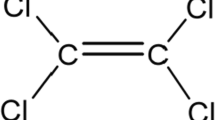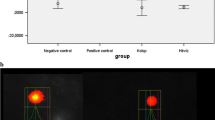Abstract
Hydrofluoric acid (HF), a solution of hydrogen fluoride in water, is widely used in producing refrigerants, drugs, plastics and aluminums. HF is not a strong acid, but it is a highly corrosive acid, capable of dissolving many materials. In this investigation, HF-induced oxidative DNA damage in lymphocytes was evaluated by comet assay. The ameliorative effect of phytochemicals on the HF-induced oxidative DNA damage was also investigated.
Similar content being viewed by others
References
Carney, S. A., Hall, M., Lawrence, J. C. & Ricketts, C. R. Rationale of the treatment of hydrofluoric acid burns. Br. J. Ind. Med. 31, 317–321 (1974).
Wong, A., Greene, S. & Robinson, J. Hydrofluoric acid poisoning: data from the victorian poisons information centre. Emerg. Med. Australas. 24, 98–101 (2012).
Burgher, F. et al. Experimental 70% hydrofluoric acid burns: histological observations in an established human skin explants ex vivo model. Cutan. Ocul. Toxicol. 30, 100–107 (2011).
Anderson, W. J. & Anderson, J. R. Hydrofluoric acid burns of the hand: mechanism of injury and treatment. J. Hand Surg. Am. 13, 52–57 (1988).
MacKinnon, M. A. Hydrofluoric acid burns. Dermatol. Clin. 6, 67–74 (1988).
Kono, K. et al. An experimental study on the biochemical consequences of hydrofluoric acid burns. Bull. Osaka Med. Sch. 28, 124–133 (1982).
Burke, W. J., Hoegg, U. R. & Phillips, R. E. Systemic fluoride poisoning resulting from a fluoride skin burn. J. Occup. Med. 15, 39–41 (1973).
Seidel, C., Lautenschläger, C., Dunst, J. & Müller, A. C. Factors influencing heterogeneity of radiationinduced DNA-damage measured by the alkaline comet assay. Radiat. Oncol. 7, 61–71 (2012).
Vandghanooni, S. & Eskandani, M. Comet assay: a method to evaluate genotoxicity of nano-drug delivery system. BioImpacts 1, 87–97 (2011).
Widziewicz, K., Kalka, J., Skonieczna, M. & Madej, P. The comet assay for the evaluation of genotoxic potential of landfill leachate. Scientific World Journal 2012, 435239–435246 (2012).
Mozaffarieh, M. et al. Comet assay analysis of singlestranded DNA breaks in circulating leukocytes of glaucoma patients. Mol. Vis. 14, 1584–1588 (2008).
Cortés-Gutiérrez, E. I. et al. Evaluation of DNA single and double strand breaks in women with cervical neoplasia based on alkaline and neutral comet assay techniques. J. Biomed. Biotechnol. 2012, 385245–385251 (2012).
Dunn, B. J. et al. Hydrofluoric acid dermal burns. An assessment of treatment efficacy using an experimental pig model. J. Occup. Med. 34, 902–909 (1992).
Dale, R. H. Treatment of hydrofluoric acid burns. Br. Med. J. 7, 728–732 (1951).
Falluel-Morel, A. et al. N-acetyl cysteine (NAC) treatment reduces mercury-induced neurotoxicity in the developing rat hippocampus. J. Neurosci. Res. 90, 743–750 (2012).
Chen, W., Ercal, N., Huynh, T., Volkov, A. & Chusuei, C. C. Characterizing N-acetylcysteine (NAC) and N-acetylcysteine amide (NACA) binding for lead poisoning treatment. J. Colloid Interface Sci. 371, 144–149 (2012).
Ponte, F. et al. Improvement of genetic stability in lymphocytes from fanconi anemia patients through the combined effects of a-lipoic acid and N-acetylcysteine. Orphanet J. Rare Dis. 7, 28–38 (2012).
Sun, Z. et al. Intravenous N-acetylcysteine for prevention of contrast-induced nephropathy: a meta-analysis of randomized, controlled trials. PLoS One 8, e55124 (2013).
Nur, E. et al. N-acetylcysteine reduces oxidative stress in sickle cell patients. Ann. Hematol. 91, 1097–1105 (2012).
Hardaway, C. M., Badisa, R. B. & Soliman, K. F. Effect of ascorbic acid and hydrogen peroxide on mouse neuroblastoma cells. Mol. Med. Rep. 5, 1449–1452 (2012).
Kumar, R. S., Narayanan, S. N. & Nayak, S. Ascorbic acid protects against restraint stress-induced memory deficts in wistar rats. Clinics (Sao Paulo) 64, 1211–1217 (2009).
Ryu, A. R., Kim, J. J. & Lee, M. Y. The inhibitory effect of phytochemicals on the oxidative DNA damage in lymphocytes by chrysotile. J. Appl. Biol. Chem. 55, 179–184 (2012).
Schachtele, S. J., Hu, S. & Lokensgard, J. R. Modulation of experimental herpes encephalitis-associated neurotoxicity through sulforaphane treatment. PLoS One. 7, e36216 (2012).
Csiszar, A. et al. Age-associated proinflammatory secretory phenotype in vascular smooth muscle cells from the non-human primate macaca mulatta: reversal by resveratrol treatment. J. Gerontol. A Biol. Sci. Med. Sci. 67, 811–820 (2012).
Murphy, C. J., Tang, H., Van Kirk, E. A., Shen, Y. & Murdoch, W. J. Reproductive effects of a pegylated curcumin. Reprod. Toxicol. 34, 120–124 (2012).
Nagajyothi, F., Zhao, D., Weiss, L. M. & Tanowitz, H. B. Curcumin treatment provides protection against trypanosoma cruzi infection. Parasitol. Res. 110, 2491–2499 (2012).
Gupta, S. C., Patchva, S., Koh, W. & Aggarwal, B. B. Discovery of curcumin, a component of the golden spice, and its miraculous biological activities. Clin. Exp. Pharmacol. Physiol. 39, 283–299 (2012).
Nabavi, S. F., Moqhaddam, A. H., Eslami, S. & Nabavi, S. M. Protective effects of curcumin against sodium fluoride-induced toxicity in rat kidneys. Biol. Trace Elem. Res. 145, 369–374 (2012).
Guerrero-Beltrán, C. E. et al. Sulforaphane, a natural constituent of broccoli, prevents cell death and inflammation in nephropathy. J. Nutr. Biochem. 23, 494–500 (2012).
Danilov, C. A. et al. Sulforaphane protects astrocytes against oxidative stress and delayed death caused by oxygen and glucose deprivation. Glia 57, 645–656 (2009).
Greco, T., Shafer, J. & Fiskum, G. Sulforaphane inhibits mitochondria permeability transition and oxidative stress. Free Radic. Biol. Med. 51, 2164–2171 (2011).
Olive, P. L. & Banáth, J. P. The comet assay: a method to measure DNA damage in individual cells. Nat. Protoc. 1, 23–29 (2006).
Park, K. S. et al. Berberine inhibited the growth of thyroid cancer cell lines 8505C and TPC1. Yonsei Med. J. 53, 346–351 (2012).
Chen, X. W. et al. Interaction of herbal compounds with biological targets: a case study with berberine. Scientific World Journal 2012, 708292–708322 (2012).
Mahata, S. et al. Berberine modulates AP-1 activity to suppress HPV transcription and downstream signaling to induce growth arrest and apoptosis in cervical cancer cells. Mol. Cancer 10, 39–52 (2011).
Author information
Authors and Affiliations
Corresponding author
Rights and permissions
About this article
Cite this article
Seo, EJ., Lee, MY. Amelioration of hydrofluoric acid-induced DNA damage by phytochemicals. Toxicol. Environ. Health Sci. 5, 201–206 (2013). https://doi.org/10.1007/s13530-013-0177-2
Received:
Revised:
Accepted:
Published:
Issue Date:
DOI: https://doi.org/10.1007/s13530-013-0177-2




